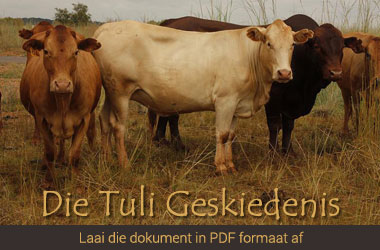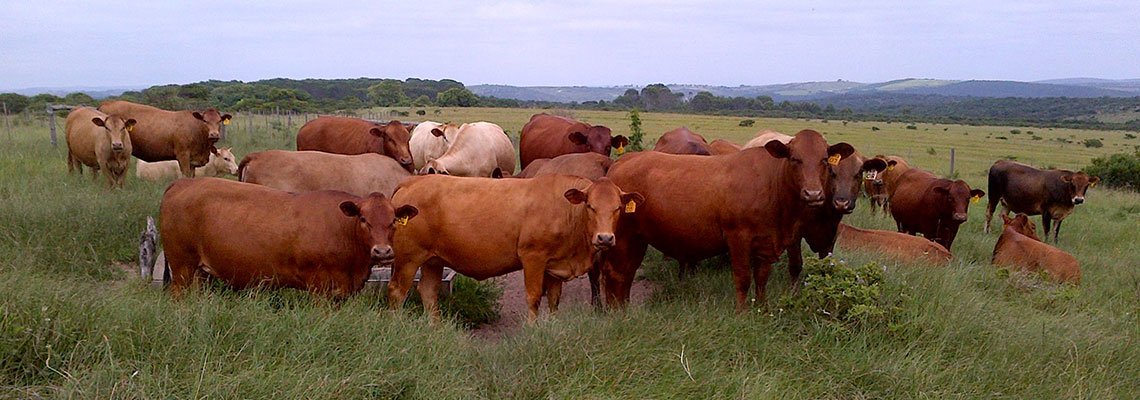 African cattle are traditionally classified into those with humps and those without. Those with humps are again divided into two groups. Cattle with humps set back on the thorax (thoracic humps) are called zebu and those with humps set more forward on the neck (cervico-thoracic humps) are called sanga. Cattle bones found in Botswana have been dated by the very latest radio-carbon technology and found to be about 2000 years old. It is believed that these early animals were brought into southern Africa by migrating tribes and in time sanga cattle became abundant in the whole area south of the Zambezi. Over centuries and through a process of natural selection the cattle adapted to different ecological climes. Small differences evolved and formed the basis for different breeds - Tswana types from which the Tuli is derived; the Afrikander with derivatives such as the Bonsmara; the Nguni and closely related Pedi, Zulu and Caprivi cattle. Since the early seventies researchers have investigated many hypotheses about whether sanga cattle are more closely related to European Bos taurus cattle from Great Britain and Europe or to Asian Bos indicus cattle. Great progress in scientific research, especially in the field of molecular genetics has made the classification of sanga cattle as a Bos taurus incontrovertible. There are, however, small but important differences (biochemical amongst others) between Bos taurus cattle from Britain and Europe and southern African sangas such the Tuli.These differences are explained by scientists as having been caused by mutations and natural selection for greater adaptability to a tropical environment. It has been suggested that it would be more correct to classify sanga such as the Tuli as a subgroup, Bos taurus africanus.
African cattle are traditionally classified into those with humps and those without. Those with humps are again divided into two groups. Cattle with humps set back on the thorax (thoracic humps) are called zebu and those with humps set more forward on the neck (cervico-thoracic humps) are called sanga. Cattle bones found in Botswana have been dated by the very latest radio-carbon technology and found to be about 2000 years old. It is believed that these early animals were brought into southern Africa by migrating tribes and in time sanga cattle became abundant in the whole area south of the Zambezi. Over centuries and through a process of natural selection the cattle adapted to different ecological climes. Small differences evolved and formed the basis for different breeds - Tswana types from which the Tuli is derived; the Afrikander with derivatives such as the Bonsmara; the Nguni and closely related Pedi, Zulu and Caprivi cattle. Since the early seventies researchers have investigated many hypotheses about whether sanga cattle are more closely related to European Bos taurus cattle from Great Britain and Europe or to Asian Bos indicus cattle. Great progress in scientific research, especially in the field of molecular genetics has made the classification of sanga cattle as a Bos taurus incontrovertible. There are, however, small but important differences (biochemical amongst others) between Bos taurus cattle from Britain and Europe and southern African sangas such the Tuli.These differences are explained by scientists as having been caused by mutations and natural selection for greater adaptability to a tropical environment. It has been suggested that it would be more correct to classify sanga such as the Tuli as a subgroup, Bos taurus africanus.
In the early 1940's in Southern Rhodesia (present day Zimbabwe) the Government was promoting a cattle improvement scheme whereby bulls from imported European breeds were made available to the indigenous people. The idea was to "improve" the indigenous cattle stock. Mr Len Harvey, a South African born agricultural advisor working for the Government, had severe reservations about the whole idea. He was convinced that the imported animals and their progeny would probably never survive the very hostile environment. Harvey had previously noticed that among the Tswana type cattle, in the south western corner of Zimbabwe where he was posted, there was a particular yellow type of sanga, consistently in good condition and seemingly better adapted to the environment. It took him four years to sell his idea to the powers that be but in 1945 3000 acre of ground in the Tribal Trust area 40km south west of Gwanda was set aside for a cattle breeding program with the "revolutionary" aim to improve the indigenous cattle through a process of selection instead of crossbreeding. The necessary infra structure was laid on and in 1946/47 the first group of 20 cows and a bull was bought from the locals and established on the farm. Within months new arrivals brought the numbers up to 60 cows and two bulls. In time the farm on the Guyu Creek, a tributary of the Tuli River, became known as the T.B.S (Tuli Breeding Station). In 1950 the T.B.S was enlarged to 20000 acre and Len Harvey became the permanent Officer in Charge. Originally the selection focus was on fertility and constitution of the cow as well as her calf with special attention given to feet and udders. Numbers had to be increased as quickly as possible but phenotype and weight per age was deemed to be of prime importance because improved meat production was the whole aim of the Tuli Project. In 1954 Tulis were entered on the Matabeleland Show for the first time and special information days were held on the T.B.S. In 1955 the Tuli was registered as an indigenous Rhodesian Breed. Although non performing animals were ruthlessly culled Tuli numbers on the T.B.S. reached 1000 in 1961. In this year too, strings of Tuli steer won all carcass competitions at the countries three most important Agricultural Shows thereby earning the coveted 'Triple Crown' Trophy for the T.B.S - much to everyone's amazement.
Although the idea was to breed better animals and to distribute these among the local tribal farmers, small numbers of animals were made available to interested commercial farmers on a sort of usufructuary system and in 1961 the Tuli Breeders Association was formed and their constitution and regulations drawn up.
In 1962 Len Harvey's important contribution to agriculture in Zimbabwe was acknowledged when an M.B.E. was awarded him by the Queen. A highlight in the early history of the Tuli happened in 1969 when the Freedom of the City of Bulawayo was granted them. Six grand bulls headed the Tuli parade through the centre of town, preceded by pipers. On the steps of City Hall the Mayor awaited them and a magnificent bull 'Sergeant' was ceremoniously presented to the city and renamed "Si Ye Pambile" which is the City motto and means 'we go forward' in the local Ndebele language. At the first public auction of Tulis in 1965 the complete offer of 39 bulls, 117 heifers and 49 cows were snapped up by enthusiastic buyers.
The 'mother herd' of 300 cows went from strength to strength. In the meantime the T.B.S Herd had been renamed the Guyu Herd and thereby hangs a tale. On 21 April 1951 the first polled bull (son of the Base Sire, Mahuke, who was scurred) was born in the dry riverbed of the Guyu Creek. He was named GUYU. Guyu's influence on the Herd was so enormous that it was later decided to name the Herd after him. Today on historical Pedigrees he features as GUYUGUYU.
In 1978 Len Harvey retired after 40 years in service. The War of Liberation which had been going on for years had reached new levels of intensity. One night in 1979 all the workers at the T.B.S were abducted. It was feared that the Tulis were in grave danger and a huge rescue action was launched by Ian Smith's Government. Convoys of Government trucks were commissioned and within 48 hours all the Tulis at the T.B.S were moved to the Matopos Research Station outside Bulawayo. Although Harvey still acted as advisor for a while the focus of action in respect of Tuli Breeding in Zimbabwe now moved to the private Breeders who had already been involved since the middle sixties.

Towards the end of 1976 the first Tulis, a group of thirty pregnant females and three bulls, were imported into South Africa from the T.B.S in Zimbabwe. The importers were the Bornmann family and a relation by marriage, Dr Fanie Kellerman. Dr Kellerman, a veterinarian, had at one stage worked in Zimbabwe where he had become aware of Tuli cattle and had been sufficiently impressed to want to import them. The first Tulis were introduced to the South African public at agricultural shows. Information days and prestige auctions were held and gradually the Tuli made its mark in South Africa too. The Tuli Cattle Breeders Society was officially formed on 24 March 1994 having been preceded by a Tuli Club.
The Tuli Cattle Breeders Society of South Africa in 10 years has seen good growth in membership with an increase of 183% to 73 members with live animals registered with SA Studbook increasing from ±5,000 animals in 2005 to 9468 animals in 2015
The Tuli is eminently suited to extensive ranching systems. It has the unique ability to utilise even the worst quality grazing and still produce top quality meat. The amazing adaptability of the Tuli is self evident if one considers their distribution. Tulis can be found flourishing in sandy, semi desert areas in Namibia, Botswana and the Northern Cape; in hot heartwater bushveld areas such as Zimbabwe, Limpopo Province and the Lowveld of Mpumalanga; in the high rainfall, sourveld of high altitude Mpumalanga and Natal where redwater and gallsickness is rife; in the Drakensberg Mountains where snow falls regularly; on the extensive savannah grassland of the Free State; in the arid Karoo with it.s unique scrub bush; in the cold, misty mountains as well as the coastal bush of the Eastern Cape. Today there are also Tulis in Australia, Canada, the USA, South America and in tropical Zambia.
The Tuli is indigenous to Southern Africa with hardiness and adaptability bred into it through a process of natural selection over a period of at least two thousand years. In recent times attributes of economic value have been the aim of scientific selection and have given us the modern Tuli. In female animals the accent has been on fertility, milk production and low calf mortality while in bulls it has been growth, feed conversion and carcass quality. Great care has always been taken not to compromise the natural hardiness and adaptability of the breed. The Tuli developed in relative isolation and has a unique genetic make up which makes it particularly successful in cross breeding programs - not only is a high degree of hybrid vigour achieved but a large percentage of polled calves as well. Tuli steers and Tuli-cross calves finish faster off the veld than many other breeds.
Conformation of visual appearance as well as performance of the Tuli is monitored and enforced through the Tuli Breed Standards of Excellence